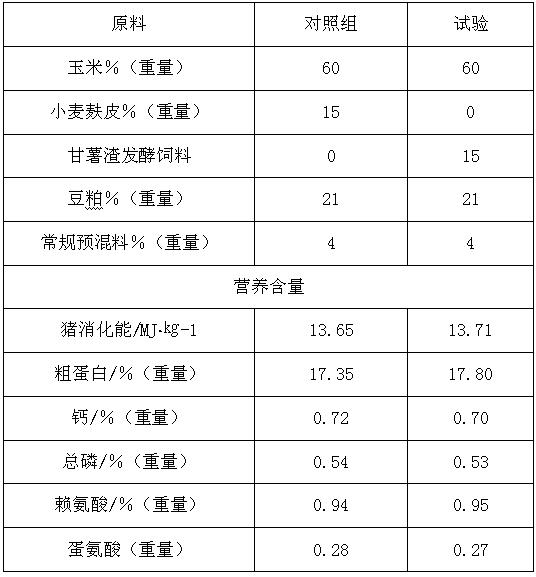Sweet potato residue fermentation feed and preparation method thereof
A technology for fermented feed and sweet potato residue, applied in animal feed, animal feed, application, etc., can solve the problems of easy spoilage, high water content, and self-contained bacteria, so as to improve palatability and digestion utilization rate, and reduce crude oil. Effect of fiber amount and nutritional value improvement
- Summary
- Abstract
- Description
- Claims
- Application Information
AI Technical Summary
Problems solved by technology
Method used
Image
Examples
Embodiment 1
[0028] The following raw and auxiliary materials and reagents were used by weight: 160 grams of sweet potato dregs, 40 grams of wheat bran, 3 grams of urea, 3 grams of ammonium sulfate, 1.2 grams of potassium dihydrogen phosphate, and 1 gram of magnesium sulfate.
[0029] Preparation method: After weighing the above-mentioned raw materials and reagents, put them into a pulverizer to crush them, and then put them into a mixer to mix evenly to make a fermentation substrate. The liquid is a combined fermentation strain bacterial liquid, wherein the bacterial liquid concentrations of Bacillus subtilis, Saccharomyces spp., Trichoderma viride and Lactobacillus plantarum are all 1×10 6 Individual / ml, the combined fermentation strain bacterial liquid is formed by mixing the bacterial liquids of Bacillus subtilis, Saccharomyces spp., Trichoderma viride and Lactobacillus plantarum according to the volume ratio of 2:2:3:1, fermented The substrate and the combined fermentation strain liqu...
Embodiment 2
[0031] The following raw and auxiliary materials and reagents are adopted by weight: 160 grams of sweet potato dregs, 40 grams of wheat bran, 3 grams of urea, 1.5 grams of ammonium sulfate, 1.2 grams of potassium dihydrogen phosphate, and 1 gram of magnesium sulfate.
[0032] Preparation method: The difference from Example 1 is that the combined fermentation strain bacterial liquid is composed of the bacterial liquids of Bacillus subtilis, Saccharomyces spp., Trichoderma viride and Lactobacillus plantarum in a volume ratio of 1:1:1:1 It is formed by mixing in proportion; the fermentation substrate and the combined fermentation strain liquid are uniformly mixed in a weight ratio of 1:1.2.
Embodiment 3
[0034]The following raw and auxiliary materials and reagents are used by weight: 150 grams of sweet potato dregs, 50 grams of wheat bran, 3 grams of urea, 3 grams of ammonium sulfate, 1.2 grams of potassium dihydrogen phosphate, and 1 gram of magnesium sulfate.
[0035] Preparation method: The difference from Example 1 is that the combined fermentation strain bacterial liquid is composed of the bacterial liquids of Bacillus subtilis, Saccharomyces spp., Trichoderma viride and Lactobacillus plantarum according to the volume ratio of 1:2:2:2 It is formed by mixing in proportion; the fermentation substrate and the combined fermentation strain liquid are uniformly mixed in a weight ratio of 1:1.1.
PUM
 Login to View More
Login to View More Abstract
Description
Claims
Application Information
 Login to View More
Login to View More - R&D
- Intellectual Property
- Life Sciences
- Materials
- Tech Scout
- Unparalleled Data Quality
- Higher Quality Content
- 60% Fewer Hallucinations
Browse by: Latest US Patents, China's latest patents, Technical Efficacy Thesaurus, Application Domain, Technology Topic, Popular Technical Reports.
© 2025 PatSnap. All rights reserved.Legal|Privacy policy|Modern Slavery Act Transparency Statement|Sitemap|About US| Contact US: help@patsnap.com

